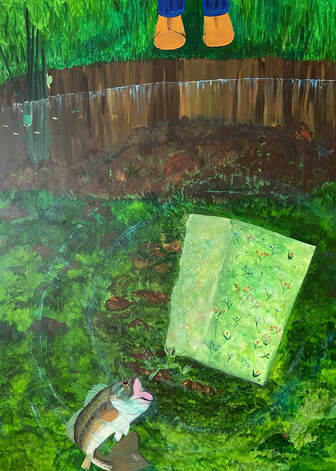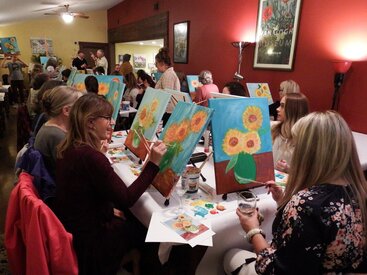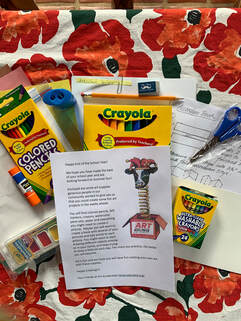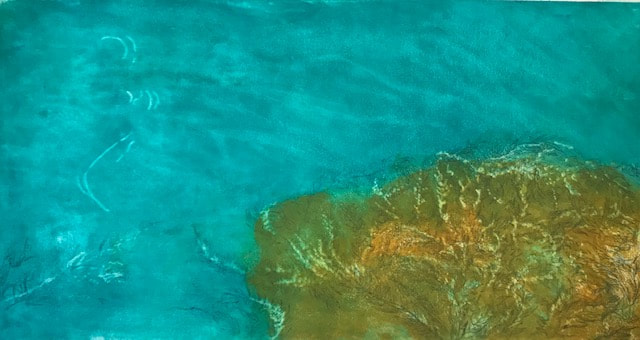|
If your student is in need of art supplies, 25 art kits are currently available for first come/first served basis at the downtown Tillamook Chamber of Commerce office at 208 Main Avenue, 9 am - noon, Monday through Friday.
Knowing that art enriches lives, Art Accelerated, through GoKids grant funding, assembled and distributed art supply kits to 200 youth county-wide. Kits include an assortment of papers and supplies needed for happily creating art projects. If you would like to participate in contributing to art kits for additional Tillamook County students, please select our "donation" box to contribute to the cause of art for kids.
1 Comment
 BY NANCY BINKLEY MARCH 10, 2020 On a sunny day, like many others, I decided to take paper and watercolors out for a walk. Coming up to a lovely little spot ablaze in a riot of color. I wet my brush in my water bottle and 15 minutes or so later I proudly signed my name and slipped the finished painting from the block. Just as it was free the wind, which was absent before, came up and took my painting. With a yell I ran after my treasure, hoping to capture it before too much damage had happened to it. It settled down on the grass and I reached out to grab it and just then, that wind, came again and took my picture high up into the air, I watched as it twisting and turning, color to white, paused and dropped suddenly onto the nearby lake. Angry and hot I approached the ruin of my art. It sadly sat there, one side sinking and the water drinking all the color away. I was heartbroken and started to turn away. Then I really looked, not at my poor ruined painting, but what was around my painting. The wind had taken my painting, that I had spent a whole 15 minutes on, and in return the wind had given me a gift that will last the rest of my life. I would have taken my painting and happily turned around and left. Never to see all of THIS. This beauty and life that took forever to create. When the wind comes up, look around and see what you missed. Good deal and I thank you all. As our readings have been cancelled because COVID-19, we are happy to share three poems
from Karen Keltz. Karen was to be our writer for the March 13th reading. GETTING WOOD WITH DAD Wood heats twice, Robert Frost said, once chopping, once burning. I think my math is better. I say the memory of wood-getting years and years later heat once more our hearts. On a summer's day, wearing chocolate brown cotton gloves too big for us, and long-sleeved shirts to save us scratches on the arms, we ride with Dad in the old clunker pickup with the whiskey flask under the driver's seat, up to Mount Fanny. Driving up a fanny makes us sisters laugh, a joke we're sure is safe from the adult next to us, his ears immune to silly twitter. Dust follows us like beggars trying to join our family. The whole valley below appears checkerboarded between the tree branches. Our house disappears, even the roof. Alongside the dirt logging road there lies a pile of slash that will keep us warm next winter if we work for it now. That's our first lesson: Things desired do not drop into our laps. The next step after wanting is work. Sawdust chucks decorate the sky in arcs as the chain saw grunts, catches, growls into action. Insects dining on rot and human sweat join the dance. Our slapping, no deterrent, seems to amuse them. Chainsaw smoke stinks up the air. After the stove-sixed cunching, Dad wields the axe and the wedge. The sleeves of his workshirt rolled up above his elbows, his muscles and sinews, say this is a man who works, this is a man who keeps his family warm in winter. This is what a man is. His arms are mahogany, but we can see the glimpse of untouched creamy skin just under the sleeve. This is our dad, too-tough outside, but tender underneath. We've seen him cry with his tongue pressed behind his teeth, and we like this about him though we don't talk about it. This is our second lesson: People are not always what they seem at first glance. As a section of log becomes quarters and eights, the sweet smell of what's held secret under bark seeps from each crackle of wedge's split. Dad stops and blows the dust from his nose on his big, red and black hankie. Now comes our turn. One girls throws, one stacks, and the pile grows a cord at a time. We're clumsy, better suited to the kitchen, and Dad barks instructions. No soft, sweet talk here. The V's are fit into openings of the tops already packed so that the stack won't fall over on the bumpy ride home. The third lesson: If we don't get it right, we do it again. This is the only practice for the final stacking at home. From the cooler we take a slug of water in a Mason jar, or the battered tin cup, and feel the overflow drip down our chins and chests into our cleavage. Particles of sawdust cling to the wet and our lips after we dry them on our arms. We pee behind the trees, then resume our work. How many cords of wood is the winter long? Other men in old pickups full of wood drive by, checking our handiwork. If there are boys in the car, we get interested and embarrassed, our hair dusty and dripping. Just a dog, we don't care. The pickup bed tacked full and tight, we head home, the landscape rising up, trees and grass and swarming bugs, to meet us. The dust comes too, joining the smoke from Dad's cigarette. Our sweat dries and cools us. Sometimes if it's a good day, we all sing. TRANSMOGRIFICATION If left to my own devices, I'd become a flower lady, you know, one of those who, like cat ladies, would have all kinds of breeds and species hanging about everywhere, on counters, mantels, backs of sofas, on end tables, on the window sill. looking out, yawning, stretching and purring, showing off their pistils, petals stamens, tubers and spores and smiling at the day. If you came to visit, they'd sit in your lap, tulips, lilies, roses and dahlias, and one little iris to sniff and nibble at your ear. GLADSTONE GARDENER I find relief In what I can count on-- wild currants flowering their cherry, cherry-hued hello the first guests I'm happy to see arrive. swallows swooning, swooping in the skies building spring homes in the birdhouses the golden baby-beaks cheeping at each oval opening after. the hummingbirds sucking nectar from the honeysuckle blossoms the bees buzzing plans in the Pieris As it was in the beginning, is now and forever shall be, Amen. The Joy rains, soothing like a warm shower at the end of a hard, hot sore-shoulder day. --What I expects happens. Art Accelerated's Gallery and Art Annex are closed until April 30th. At this time, when the help of our volunteers, artists, students and patrons are the utmost concern. It is what we must do!
We will be looking at ways to connect with everyone in the days ahead. Check in with us on Facebook & Instagram. Do what you need to do be safe and well! Peace and Love to you! Art Accelerated, Gallery Manager & Board Member  “Never doubt that a small group of thoughtful, committed citizens can change the world....” -Margaret Mead You never know what can happen when you get a small group of people headed toward the same cause with a mission in mind. Not that we’ve changed the world, but maybe we’ve had a positive influence on our community and brought light to our little part of this great big world! Yes, it’s been another year packed with activity for Art Accelerated, the local, all-volunteer, art group with a mission to bring art to adults and kids in downtown Tillamook, because we know that all growing communities need a vibrant art presence for all souls: a place where one can create to his/her heart’s desire-adults and children alike. This year, Art Accelerated sponsored, free and open to the public, numerous opportunities to enjoy art in downtown Tillamook. Every fourth Saturday of the month, the public visited various downtown businesses and perused different artist’s work celebrating their creative spirits. Sip and Shop each month on the second Friday downtown also provided an opportunity at the Art Accelerated Gallery for local writers, published or unpublished, to read from their poetry or prose while listeners provided support and encouragement to the authors. Monthly Open Mics at Yo Time, mcd by Rick Persons and Penny Eberle provided a chance for artists to share a story, a song or poem in another family friendly environment. Besides our monthly events for the public, we taught art classes for adults in painting and drawing along with children’s art classes for varying age groups, and held a popular Shibori workshop and memoir writing workshop along with our successful Paint Night Events several times during the year. Right after the New Year in 2019, we took the opportunity to lease classroom space directly behind the Gallery. The Art Annex has served us well as a convenient location to house our art classes as well as our Writer’s Meet up the first Wednesday of each month. Our downtown art presence in the heart of downtown Tillamook continues in the Art Accelerated Gallery, located right behind the Tora Restaurant at 1906 Third Street, where we showcase our local artists’ work from photography, to acrylic painting, to literary works, to sculpture to water color---you will find local talent celebrated in the Gallery which is open Thursday, Friday and Saturday each week. Our goal is to continue growing and bringing more art opportunities to our downtown. We THANK YOU for your support and participation over this past year. Obviously, we NEED YOU to continue this mission of bringing art to the heart of downtown Tillamook. In order to thrive, we need your continued support in the following ways: *Current members, please consider renewing your membership to Art Accelerated as soon as possible by going to artaccelerated.organd click on the donate button on the home page. If you aren’t a member, please consider becoming a member of Art Accelerated by going to artaccelerated.org and click on the donate button on the home page. We need businesses and individuals to consider sponsorship of classes and activities above and beyond a membership to Art Accelerated. Would you like to be involved in volunteering for Art Accelerated? Are you an artist needing an audience? We are always needing Gallery artists and artists to participate in Artwalks. If any of these opportunities are something you are interested in, contact Christine Harrison at: 503.809.9172 or email at: [email protected] Again, we THANK YOU for your support of our mission: bringing art to the heart of downtown Tillamook for adults and children in our community. We probably haven’t changed the world yet, but we have brought more art and light into the lives of many. Our world, our community needs this opportunity more than ever. Please, join us this year! With gratitude, Cindy Gardner for Art Accelerated Board: Christine Harrison, Dennis Worrel, Sierra Lauder, Anne Harper Dennis Worrel, a co-founder of Arts Accelerated, first got his initiation into art at a young age. He and his cousin sat at the kitchen table and drew pictures for his grandmother. For him, it was something fun to do, and his first audience enjoyed it and encouraged him.
|
|




 RSS Feed
RSS Feed